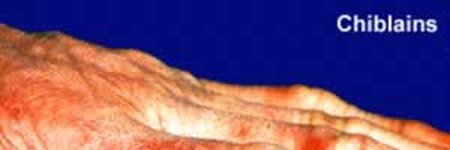Chilblains
DEFINITION
Chilblains are small, itchy, painful lumps that develop on the
skin as an abnormal response to cold.
skin as an abnormal response to cold.
DESCRIPTION
Chilblains are a common condition that can cause pain and
discomfort but do not cause permanent damage. Chilblains have a
white or slightly bluish appearance, range in size and occur most
commonly on the fingers and toes. Chilblains are caused by a
reduction in the amount of blood that flows to the outer layers of
the skin, which occurs during cold temperatures when the body tries
to conserve heat by directing blood away from the skin. Chilblains
are often reported by people who must work with their hands
uncovered in a cold environment. Chilblains occur in people of all
ages, including healthy, young adults but it is not clear why only
some people get Chilblains when their skin gets cold It seems that
some people have special forms of proteins in their body that react
unusually to cold temperatures by clumping together. Chilblains
seem to be more common in people who have Raynaud’s phenomenon or
Raynaud’s disease (these are conditions where the blood vessels
contract excessively). Also, people with systemic lupus
erythematosus or HIV may be more susceptible to Chilblains.
discomfort but do not cause permanent damage. Chilblains have a
white or slightly bluish appearance, range in size and occur most
commonly on the fingers and toes. Chilblains are caused by a
reduction in the amount of blood that flows to the outer layers of
the skin, which occurs during cold temperatures when the body tries
to conserve heat by directing blood away from the skin. Chilblains
are often reported by people who must work with their hands
uncovered in a cold environment. Chilblains occur in people of all
ages, including healthy, young adults but it is not clear why only
some people get Chilblains when their skin gets cold It seems that
some people have special forms of proteins in their body that react
unusually to cold temperatures by clumping together. Chilblains
seem to be more common in people who have Raynaud’s phenomenon or
Raynaud’s disease (these are conditions where the blood vessels
contract excessively). Also, people with systemic lupus
erythematosus or HIV may be more susceptible to Chilblains.
TREATMENT OPTIONS
Always consult your Doctor for the diagnosis and treatment of
Chilblains. The treatment for Chilblains is keeping the affected
part of the body (e.g. fingers and toes) warm and if a Chilblain
ulcerates and becomes infected, topical antibiotic creams or other
medications may be required. In people who are particularly
susceptible to Chilblains, oral medication may be given that
dilates (opens) the blood vessels, which allows blood to flow to
the outer layers of the skin. This can help prevent Chilblains from
forming.
Chilblains. The treatment for Chilblains is keeping the affected
part of the body (e.g. fingers and toes) warm and if a Chilblain
ulcerates and becomes infected, topical antibiotic creams or other
medications may be required. In people who are particularly
susceptible to Chilblains, oral medication may be given that
dilates (opens) the blood vessels, which allows blood to flow to
the outer layers of the skin. This can help prevent Chilblains from
forming.
DIET HINTS
Eat a balanced diet. This will enable the body to feel as
energetic as possible and improve the body’s ability to heal and to
fight infection. The following steps are recommended:
energetic as possible and improve the body’s ability to heal and to
fight infection. The following steps are recommended:
- Enjoy a wide variety of nutritious foods.
- Eat plenty of breads and cereals (preferably wholegrain),
vegetables (including legumes such as those found in the pea and
bean families) and fruits. - Eat a diet low in fat and, in particular, low in saturated
fat. - If you drink alcohol, limit your intake.
- Eat only a moderate amount of sugars and foods containing added
sugars. - Choose low salt foods and use salt sparingly.
Please see the Healthy Eating Diet on the Healthpoint for
further information.
further information.
VITAMINS/MINERALS/HERBS
- Vitamin B3 (in the form of nicotinamide) can increase
circulation to the peripheries. Ask your Doctor. - Calcium and magnesium are minerals involved in the contraction
and relaxation of blood vessel walls and play an important role in
maintaining healthy blood circulation - Ginkgo biloba is a herb that is used to help improve the flow
of blood to the head and hands and feet. Ginkgo has a long history
of traditional use as a remedy for improving Chilblains. - Ginger (Zingiber officinale) is a herb with anti-inflammatory
properties. The pain of Chilblains is usually worse in cold
weather. Ginger has a warming effect on the body and may help to
reduce this pain. - Cayenne (Capsicum minimum) helps to stimulate blood flow and
promote healthy blood circulation. Cayenne may be used in
conditions marked by poor circulation to the hands and feet
including Chilblains. - Prickly Ash has been used traditionally by herbalists to
improve poor circulation.
PHARMACIST’S ADVICE
Ask your Pharmacist for advice.
- Follow the Diet Hints.
- A corticosteroid cream may relieve the itching and soreness.
Ask your Pharmacist for advice. - If a Chilblain becomes ulcerated and/or infected, ask your
Pharmacist about an appropriate wound dressing and antibiotic
cream. - Regular exercise can help improve the circulation.
- One of the best ways to prevent Chilblains is to wear warm
clothing e.g. gloves in wintertime - Cigarette smoking causes constriction of blood vessels, which
may increase the risks of developing Chilblains. Ask your
Pharmacist about a range of smoking cessation products that may be
of assistance. - Consider some nutritional supplements if the diet is
inadequate.

